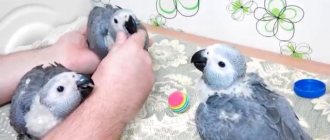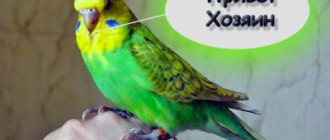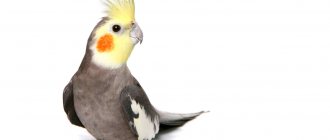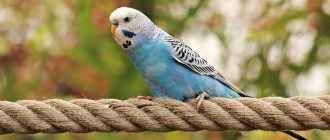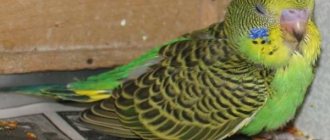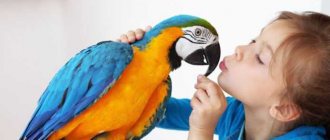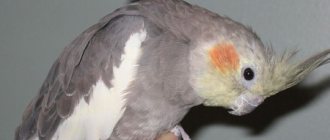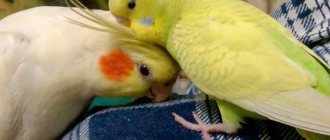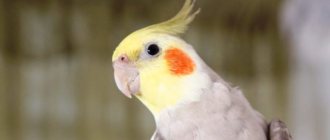Fans of exotic pet parrots often prefer Corella. And no wonder: the pet is beautiful and friendly. And most importantly, he is a talking parrot and a wonderful artist: Corella sings, dances and imitates the sounds of even household appliances, which greatly amuses his owners. Our step-by-step instructions, videos and audios will help you train your feathered pet to become a star.
Learning to speak
Cockatiels have gained popularity primarily due to their ability to speak. Of course, they are not born with this skill, but it is quite possible to train them. In the next video we invite you to admire the handsome man and listen to him speak.
Which parrot is suitable?
Corellas are a talking species of parrot, so they are not only capable of making high-pitched screams and other incoherent sounds, but they can also learn to imitate speech. This requires your patience, perseverance, and also the right approach to choosing a bird that can learn to talk. Males learn best and fastest. Before you buy your future friend, listen to his voice. In addition to monotonous squeaks, shrill sounds and screams, you should hear coherent sounds, something similar to notes.
You should not start teaching an adult bird to talk in order to achieve the desired effect; Corella must learn from a young age, so we advise you to purchase a small chick. You can only start lessons away from other birds, so don't buy multiple parrots if you want them to talk. Otherwise, the birds will have enough communication in the form of shouting to each other and they will not perceive your lessons. Also make sure that your cockatiel is healthy, otherwise your parakeet may not be able to learn.
Step-by-step instruction
- You should not start lessons from the first day, let your pet get used to you and the new environment. Get your cockatiel accustomed to being held, play with the bird often and don't forget to praise.
- Lessons should be taught all the time by one person for 40-50 minutes every day, dividing the lessons into several parts (preferably in the morning). It is preferable that it be a woman, since Corella perceives female voices more easily.
- Choose a few simple phrases that you say often, loudly, clearly and with the same intonation. It is desirable that in phrases and sentences the sounds “a”, “o”, “p”, “k” are often found - they come easiest. You can move on to the next phrase only when the bird clearly learns to pronounce the previous one.
- You need to talk to your parrot kindly and only when the bird is in a good mood. Be sure to praise your pet for success and reward it with treats.
- The key to successful learning is regular practice! If you prove yourself to be a wise and persistent teacher, the results will appear within a couple of months.
Screams, onomatopoeia and individual phrases can be heard in the recording.
Basic questions about parrots
Is it possible to keep one parrot or does it need a pair?
You can absolutely safely keep a parrot alone. The fact that they cannot exist alone is a myth in which there is some truth. If you separate a long-formed pair, the birds can really start to get sick, get bored and even die. However, this does not apply to those birds that have not lived together for very long.
If you keep a bird alone, you need to provide it with companionship and interesting toys. To do this, you must have a lot of time to keep the parrot company. He will become a faithful companion in all household chores.
If you don’t have much time, it’s better to buy a pair. It is advisable to take a boy first, then a girl, introducing them gradually and spending quarantine.
It is very difficult to tame a pair, and most likely they will never be able to trust you completely, like a parrot without a mate.
Does a parrot need a mirror?
No. The parrot sees him as a friend and can become very attached to him. This may cause the parrot to not fly out of the cage, communicate with other parrots, and be very difficult to tame.
Is it possible to play bird recordings for a parrot?
No. This is a lot of stress for a parrot. He begins to look for relatives, but cannot find them. This will lead not only to stress, but also to depression, because the recordings may contain disturbing messages.
The parrot sits on one leg, is this normal?
Yes. This is how birds rest and sleep. If a parrot sits on one leg, fluffs up, creaks its beak and is relaxed, it means it is resting.
If the parrot tucks one paw, does not stand on it all the time and is limping, you need to show the bird to an ornithologist.
My parrot is bald under his wings. This is fine?
Yes. Parrots by nature have no feathers under their wings, only down.
The parrot has a hole under its beak. This is fine?
Yes. This is the structure of a parrot's beak; it has a gap between the mandible and the neck. There are no feathers under the lower part of the beak - this place is covered by feathers growing nearby.
My parrot is sneezing! This is fine?
They sneeze just as wetly as humans.
If the sneezing continues constantly, and wet discharge flows from the nose, the parrot is lethargic, trembling and tufted, you need to contact an ornithologist
The parrot opens its beak. This is fine?
Rhythmically opens its beak, as if breathing it - experiencing stress
If he raises his head and seems to swallow, then he pushes the grains from the crop inside. If this happens for a long time, you need to examine the bird
If you talk to him at the same time, he listens carefully
Hisses and opens beak - angry or snaps
The parrot creaks and clicks its beak. Why?
This way he cleans his beak. Parrots have horny teeth on the inside of the beak, which, like a file, sharpen the front part of the beak and clear the grains from the husk and are used to pick fruits.
How do cockatiels sing?
Talking Cockatiels are wonderful performers; they can not only talk, but also sing. There is an opinion that males are best at this craft, but you can often find a singing female - everything is individual. The Corella parrot sings from the age of 2 months, but their talent especially develops at the age of two years. The pet makes very melodic sounds during mating games, when the parrot not only sings, but also dances in front of the female. In the next video you will learn how the Corella parrot sings.
Instructions on how to teach singing
Many breeders are interested in the question: how to teach a Corella to sing? After all, if you learn to talk easily enough, then Corella’s singing instead of her screams can be heard only after many months of hard work.
- A parrot's talent for singing manifests itself if it feels great self-love, care and attention. Therefore, first establish a good relationship with your pet.
- Choose an unobtrusive melody and whistle it constantly.
- After some time, burn the melody to a disc and play it regularly to listen to when you are not at home. This will brighten up your pet’s loneliness and be beneficial - soon he will delight you with sonorous songs.
We invite you to listen to an audio recording of the Corella parrot singing.
Amazing abilities
Like all birds, cockatiels make a variety of sounds, from whistling to singing. Every cry or song means something. With some exclamations, the parrot may demand to be fed, let out of the cage, or simply to pay attention to it.
Long, high-pitched sounds can tell you that something is bothering your pet. For example, fear or a painful condition. In this case, you must rush to his aid. In the article “Character of the Corella Parrot” we looked at this behavior of the bird.
The first musical abilities of a pet are manifested in its chirping and chirping. Such sounds indicate both the parrot’s desires and a good mood. Perhaps the bird is happy about your arrival, free flight around the room, or its favorite treat.
Sometimes the onomatopoeia of parrots can confuse the owner. When they imitate the ringing of an alarm clock, the ringing tone of a mobile phone or the doorbell, the owner does not immediately understand that this is a kind of bird prank.
Cockatiel nymphs sing when they experience bright feelings and pleasant sensations. But if you do not pay enough attention to your pet, it is unlikely that he will want to open up so much that he will sing freely and regularly. Only a loving and caring owner deserves to hear his joyful and happy songs. If cockatiels sing, then you are a good owner.
Corella also dances!
A parrot can be taught not only to speak and sing, but even to dance! While dancing, the bird looks like a real artist. The dance performance, which is often accompanied by rhythmic screams and other sounds, will not leave you and your guests indifferent. How the talking parrot Corella speaks and sings, and even dances during this Lambada, we suggest you watch in the video.
Dancing school
In order for your talking pet to start dancing, be in a positive mood yourself, because you will have to teach the bird by your own example.
- Play energetic music that is played frequently in the house and that your budgie knows well.
- Stand in front of your pet and do rhythmic dance movements. Especially use body jerks, head turns and arm movements.
- Soon the feathered beauty will begin to imitate movements and dance.
You will have to dance every day, or better yet several times. But don't do this if your pet is in a depressed mood.
How to behave with a budgie in the first days at home
Living conditions are important not only for people. Budgerigars are traditionally kept in cages, although later it will be possible to decide on partial “self-walking”: the birds are smart enough that they can be released to fly within the confines of an apartment. The main thing is to make sure there are screens on the windows and that there are no hazards. But at the initial stage of adaptation, the cage becomes the best place to keep it. For a budgerigar to properly adapt, its personal home should be like this:
- size - no less than 50x40x60;
- several perches are required;
- hang a couple of toys;
- clean water and fresh food;
- place the cage in a warm place without a draft - birds catch cold easily.
For the first few days, the best approach is to touch your pet as little as possible. The initial adaptation is to provide the parakeet with everything it needs and leave it alone in a comfortable, quiet place. This period may take two to three days. It is worth preparing for the fact that the bird will still experience stress from changing its usual environment to another, and also keep the following signs in mind:
- Refusal of food. Normal on the first day, but if it lasts more than 6-8 hours, you should think about other reasons besides stress. Parrots eat a lot relative to their body weight; prolonged food refusal can mean more serious problems than just stress. If a pet gradually approaches the feeder, but for now it seems to be “stealing” food, this is normal, it is hungry and hunger will sooner or later take its toll, the main thing is to overcome fear.
- Loose stools. As with other animals, diarrhea in budgies can be either a result of stress or a sign of illness. It goes away within a day or two. Additional advice: do not change the food, even if you purchased the bird at a pet store, where the food was not the best, you should not immediately switch to even better food.
- Indifference and low activity. They are also a sign of fear; the parrot tries to show itself as little as possible, afraid of being noticed. The parrot returns to normal in two to three days, gradually giving way to curiosity and a desire to explore new territory. You should be concerned about illness if it lasts longer or if there are other obvious signs of ill health.
- Excessive activity, panic. If a budgie rushes around the cage and cannot find a place for itself, then this is also a sign of stress. The only way is to create twilight and silence in the room so that he calms down and falls asleep for a while. When the bird wakes up, it will feel better.
Remember that parrots have a rather sensitive nervous system. A young healthy pet, of course, will survive the problem of moving without much difficulty
During the adaptation of a budgerigar to a new place, it is important not to add anxiety to it, monitor its comfort and adherence to all safety rules. If handled incorrectly, the bird can get sick and even die, so the owner should take careful care of the parrot
Not tweeting because he's sick
The most alarming reason for a pet’s silence may be the initial signs of the disease. A reason for concern may be the sudden silence of the parrot, accompanied by other symptoms of an unhealthy condition, including:
Loss of appetite and lack of attention to offered treats;
- sleepy state - the bird moves little and constantly sits with a ruffled look;
- apathy, retardation of movements;
- cough or sneezing;
- indigestion, including loose stools;
- discharge from the beak, itching;
- indifference to external stimuli;
- discoloration, increased loss of feathers.
Tips and tricks
Beginning breeders often do not know some of the nuances of training parrots. This reduces the quality of work and increases the training period. To establish strong associative connections in your pet's brain, you must always combine the pronunciation of words chosen to be memorized with actions that illustrate their meaning.
Experts advise:
- Choose a pet cockatiel for training.
- Monitor your pet's mood. If the parrot is upset, the lesson is skipped.
- Do not share the learning process with anyone. You can get good results with just one teacher.
- Do not handle a sick bird.
Parrots don't start training with long words. The principle “from simple to complex” is practiced. Owners who scold or punish their charges for mistakes risk losing contact with the bird forever.
Teaching a parrot to imitate a human voice
Budgerigars need to be taught to sing when they are very young. It is much more difficult to teach adults to sing, although such cases also occur. Birds know how to listen . It is best to start training one parrot, as it is more difficult to train two. If you have two pets and one of them is already trained to sing or talk, then the training will be much more effective.
- Every day you need to work with your pet on average for a third of an hour. In this case, the parrot will begin to please you within two months. The bird loves when you give it a lot of time and listens to you talk. Repeats words and sounds in gratitude.
- At first, the words should be the simplest, with no more than two syllables. Birds love praise and try their best. Information should be presented with an emotional connotation; budgies, when listening to it, repeat it faster. When the time comes to teach phrases, they should be situationally appropriate to the place.
- If the parrot is indoors for the first time, and the place is unfamiliar to him, he may remain silent for a long time. You shouldn’t demand the impossible from him, let him look around and get used to it. After adaptation, everything will return to normal.
- The best time to study is evening or morning. During the daytime, your feathered pet will give in to sleep. Never force your parrot to do anything he doesn't want to do. Sensitive birds may be frightened by such a rush. It should be noted that these birds are distinguished by their vindictiveness; if they are offended, then for a long time.
Interesting: Food for tits - what to put in the feeder?
How to care for your pet so that it learns to sing?
It is also important for the cockatiel to constantly release it into the wild. If this is not done, then he will chatter incessantly, which cannot have a positive effect on his learning process. So if you want the bird in your house to sing the songs of your favorite artist, you need to pay special attention to caring for it .
Otherwise, the bird will chatter, which will only cause irritation instead of delight. The bird should feel completely comfortable. For this to happen, it is necessary not only to feed the cockatiel well and tasty, but also to provide it with everything possible for its well-being. What exactly do you need to do?
- Provide full access to light to the cage. In any living organism, photons stimulate the production of joy hormones. So, with good lighting, your bird will feel better.
- The cage needs to be cleaned constantly. This is important not only for you, but also for the bird. After all, the cockatiel is not used to living in such ugly conditions, which arise on their own when it is not cleaned for some time. She is genetically wired to live in paradise. You shouldn’t take this goodness away from her.
- Monitor the temperature inside the cage. It is clear that a cockatiel will not sing if it is cold. Yes, she won’t even be able to sing the song “Oh frost, frost.” After all, she does not understand its meaning, but only reproduces it. Desirable temperature limits for poultry are from 20 to 25 degrees Celsius. If below this threshold, then the bird will be cold. After all, she was accustomed to the warm Australian climate, and not to the harsh Russian winters.
- It is also necessary to monitor humidity. To maintain it at a certain level, you need to buy an air humidifier and regularly irrigate the cage with it. Just don't overdo it.
- Make sure there are no drafts. Birds don't like this. What about birds, even people don’t really like drafts. So be sure to keep an eye on this factor so that the cockatiel lives and sings in full voice.
Interesting: All about raising Corella parrots at home
In general, you should follow the rules for caring for your bird at any time of the year and regardless of what your mood is.
The likelihood that your cockatiel will want to chat with you or even sing a song from your favorite artist in live high-quality sound mode depends on this.
In this article, we figured out how cockatiels sing and what needs to be done to ensure that their singing never stops. Actually, you can feel the state of the bird. The main thing is that you do not confuse singing with grinding. You can even draw an indirect correlation between a cockatiel's lifespan and how much it sings.
The more this is demonstrated, the better your pet's quality of life. So keep an eye on and love your pets. Believe me, they will be grateful to you.
Songs are for budgies
Having learned to listen, your pet will open and close its eyes without much anxiety. This moment cannot be missed ; at this time you need to start teaching the parrot to sing. To do this, you need to turn on the player with a beautiful, melodic song. Possible with songs and chirps of other birds. You choose the music at your own discretion.
- As soon as the first positive results appear, the parrot will quickly begin to gain experience and learning will proceed quickly. After all, by their nature, budgies tend to talk and sing a lot.
- Do not stop at the achieved results, continue the course of training, talk to your pet, sing with him, listen to new music. In sleepy times, you can enjoy the singing of your feathered pet.
- Parrots sing especially beautifully in the evening. You can enjoy their performance and take a break from everyday work. Your joy will know no bounds.
If you don’t have a parrot, but you need to hear its singing, you can use the video and listen online while sitting in your apartment. You can listen not only to budgerigars, but also to how macaws, cockatoos, grays and other songbirds sing.
